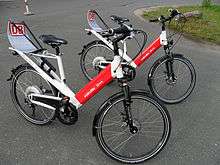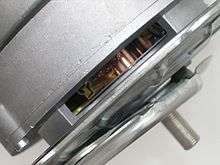Pedelec



A pedelec (from pedal electric cycle) is a bicycle where the rider's pedalling is assisted by a small electric motor; thus they are a type of low-powered e-bike. However, unlike some other types of e-bikes, pedelecs are classified as conventional bicycles in many countries by road authorities rather than as a type of electric moped. Pedelecs include an electronic controller which cuts power to the motor when the rider is not pedalling or when a certain speed – usually 25 km/h (16 mph) – has been reached. Pedelecs are useful for people who ride in hilly areas or in strong headwinds. A pedelec can be any type of bicycle, but a pedelec city bike is very common. Ordinary conventional bicycles can be converted to pedelecs with the addition of the necessary parts, i.e. motor, battery etc.
In many places pedelecs are legally classed as bicycles rather than as mopeds or motorcycles. Other kinds of e-bikes, such as the more powerful S-Pedelecs and power-on-demand e-bikes (those whose motors can provide assistance regardless of whether the rider is pedalling or not) are often classed as mopeds or even motorcycles and the rider therefore must conform to the conditions that apply to users of those vehicles, e.g. being licensed, wearing a helmet, vehicle registration etc.
Advantages and disadvantages
Pedelecs provide various advantages over conventional bicycles:
- Mobility: People living in hilly areas can cycle using a pedelec rather than be forced to rely on fully motorised transport (i.e. cars or motorbikes). This is particularly of use to the older people who may no longer have the capacity for strenuous exercise that hill climbing demands that they once had.
- Speed: Destinations can be reached more quickly, since the average speed is higher for the same amount of effort.
- Effort: Alternatively, the same speeds can be reached with less effort. This means that a rider on a pedelec can sweat less if at all – particularly when going up hill – so that bicycle commuting in work clothes is made less problematic, i.e. eliminating the need to change and/or shower upon getting to work.
- Higher range: Since the rider will be less fatigued, and average speeds higher, greater distances can be attained.
The main disadvantage is the purchasing cost of the pedelec itself, which is significantly more expensive than a conventional bicycle of the same type: the average selling price in Germany is between €1,500 and €2,000.[1] The other additional expenses are minor: these are the electricity recharging costs and the eventual replacement of the battery, which together have been calculated to cost a mere €0.20 - €0.40 per 100 km.
History
In 1989, Michael Kutter, founder of Dolphin E-bikes, designed and produced the first pedelec prototype.[2] The first market-ready models of this kind were available in 1992 from the Swiss company Velocity under the name Dolphin.
In 1994, larger numbers were produced by Yamaha under the name Power Assist.
In 1995, the first Flyer in the same year founded the Swiss start-up company BKTech AG in small series by e-business (as an integral part of the start-up) to the market.[3]
The term pedelec was first used by Susanne Brüsch in her thesis in 1999.[4]
Pedelec market penetration
Europe
Throughout the whole of Europe in 2011, between 900,000 and 1.24 million units were sold; this is 29% more than in 2010.
It has been predicted that in 2015, 3 million e-bikes will be sold in Europe, and these will mostly be pedelecs.[5]
Germany
As of 2012 there were about 600,000 pedelecs on the road in Germany.[6] Growth has been spectacular: the year before, 310,000-340,000 pedelecs were sold in Germany and this in turn was 55% more than in 2010.[7] In fact, in Germany sales have gone up by more than 30% every year since 2008.[1] In comparison, there were around 70 million conventional bicycles in Germany in 2011 according to ZIV, the German Bicycle Industry Association.[1]
About 95% of all e-bikes in Germany are in fact pedelecs.
ADAC, the German (auto)motive club has tested a large number of pedelecs in 2013, where about 70% of the pedelecs failed the test with a score lower than reasonable due to unsatisfactory safety and durability.[8]
Elsewhere
Only the Chinese market for pedelecs and e-bikes is higher than the European. According to the National Bureau of Statistics in China more than 100 million e-bikes are on the road. The annual production in Chinese factories has increased from 58,000 (1998) to 33 million in (2011).
Legal status of pedelecs worldwide
It is important for a pedelec to be legally classed as a bicycle in each country or jurisdiction rather than classed as a moped or motorcycle. The danger is that if a pedelec is classed as a moped or motorbike then it may not be allowed in bike lanes or on bike paths; the pedelec may have to be registered; the rider may have to wear a motorcycle helmet; and/or vehicle insurance may have to be paid for.
This means it is important to legally distinguish between pedelecs and other e-bikes (including S-Pedelecs) as these are likely to 1) have a more powerful motor than 250 W, 2) they may be able to attain a higher speed than 25 km/h before the electric motor assistance cuts out (if it cuts out at all), and/or 3) may have the ability to travel via electric motor alone (i.e. without pedalling). If any of those three conditions are true, then the bike is therefore more likely to be legally classed as a moped or motorcycle rather than as a bicycle.
Europe
Austria (Highway Code and CFG)
According to § 2 para 1 of 22 StVO 1960 two types of electric bikes can be distinguished:
- Lit. "B) a [bike], which in addition to an electric drive according to § 1 2 KFG 1967 is equipped (electric bike)" (thus hybrid drive according pedelec definition ');
- Lit. "D) an electrically driven vehicle, the drive corresponds to an electric bicycle as defined in § 1 paragraph 2a KFG 1967" (thus a just-electric drive).
Not as motor vehicles under § 1 paragraph 2a KFG apply electric bicycles - whether hybrid (pedelec) or exclusively powered by electricity - with a bicycle for purposes of traffic 1960
- A maximum permissible power of not more than 600 watts, and
- a design speed not exceeding 25 km/h.
Provided above criteria are not exceeded is, therefore, under Austrian law, such an electric bike / pedelec not as electric power rad and therefore requires neither approval nor vehicle registration. As for normal (only muscle powered) bikes, also for electric bikes, the provisions of bicycle Regulation, for the control of these are the same as those for muscle StVO-powered bicycles, etc. Mandatory use of the bike path lane with bicycles. For their (commercial) In placing on the market subject to the product liability provisions.
In Austria, S-Pedelecs (power-assisted pedalling up to 45 km/h) are not classed as bicycles. Whether they lit at best as moped According to Article 1 paragraph 2. A) Directive 2002/24/EC (or as motorbike § 2 Abs 1 line 14 KFG) are typable and registered as a motor vehicle can be driven, so far (October 2010 has not survived).
The Netherlands
The true Pedelecs are not required to have any additional prerequisities than a bicycle has.
However, any pedelec where the power assistance is triggered by merely turning wheels rather than pedal motion (a large number of cheap versions or notoriously front hub assistance), are required to have a licence plate for a scooter / small motorcycle (so called snorfiets or bromfiets), a valid driving licence and an insurance.
In case of the power assistance stopping at a speed up to 25 km/h, the riders are not required to carry motorcycle helmets, however, this speed limit shall not be exceeded even while pedaling only. Electric bicycles, for example Specialized Turbo, without 25 km/h speed limitation for power assistance are considered a small motorcycle and besides license plate (yellow with black letters), driving license and insurance, a motorocycle helmet must be worn at all time from the start of 2017 and onwards.
Very surprisingly, a large fleet of electric bicycles and pedelecs without required power control linked to the pedaling effort can be seen on the cycling paths without any proper registration. Additionally, many users found very simple ways how to tweak their pedelecs in order to overcome the pedaling sensor, making their pedelecs without further proper vehicle registration illegal.
Asia
Hong Kong
Pedelecs, and any other kind of mechanical assist, is illegal, and first offenders are liable to fine and imprisonment up to 3 months, while repeat offenders up to 6 months.[9]
Singapore
Pedelecs are allowed, when wearing a helmet, the motor output is limited to 200W and the motor cuts out by 25 km/h [10]
Australia
As of 30 May 2012, Australia has an additional new electric bicycle category using the European model of a "Pedelec" as per EN15194 Standard. This means the bicycle can have a motor of 250 watts continuous rated power which must be activated only by pedalling (if above 6 km/h) and must cut out over 25 km/h. The State of Victoria is the first to amend their local road rules to accommodate this new standard as of 18 September 2012.[11]
Technical
Components
Pedelecs differ from an ordinary bicycle by an additional electric motor, a battery, an electronic control system for the motor as well as a sensor to detect the motion of the cranks. Most models are also equipped with a battery charge indicator and a motor power setting, either continuously or divided into support levels.
Battery
Besides the motor, the battery is the main component of pedelec technology. It is usually either a NiMH - Ni - or a lithium-ion battery. The battery capacity is up to 24 Ah n (Ah) at 24 or 36 V (V) or up to 15 amp hours at 48 volts. The stored energy can be up to about 800 watt hour n (Wh), but mostly about 400 Wh (2013). In ideal conditions, after a thousand charges NiCd batteries have 85% of their original capacity and are therefore considered worn. With NiMH batteries about 400 to 800 cycles are possible. The charging time depending on the type of battery is around 2 to 9 hours. The durability of the battery is dependent on other factors. As lead-acid batteries discharge they provide less power, so that full motor power is no longer achieved. The very light, more expensive lithium ion batteries are now used by most manufacturers and have a range of up to 100 kilometers with moderate pedaling and a medium capacity battery (e.g. 15 Ah). Lithium batteries do not tolerate frost and should not be charged at frosty temperatures. For safety, the chemical composition and the quality of the electronics are crucial. Especially with short circuit and over voltage, lithium-ion batteries react very strongly. These problems in laptops have led to recalls. Lithium iron phosphate (LFP) batteries are a notable exception. They have far safer thermal characteristics as well as being non-toxic.
In evaluating pedelec batteries, it is useful to consider not only the capacity, but also criteria such as durability, memory effect, charging time, weight, safety and environmental protection.
Manufacturers which equip their pedelecs with NiCd batteries usually deliver them with an AC adapter that discharges the battery completely before the actual charging process in order to decrease the memory effect. NiMH batteries have a much lower memory effect. With lithium-ion batteries there is no memory effect.
A lithium iron phosphate battery is much longer-lived than a lithium-ion battery. Its use significantly reduces operating costs resulting from battery wear. In 2013, they are not yet available as standard in most pedelec models, but some pedelecs (e.g. Beyond Oil) have begun installing LFP batteries as standard.
Motor Control
For switching or control of the motor, there are several possibilities:
- Measuring the force or torque on the signal of a force sensors on the pedals, the pedal crank, the chain or at the wheel
- Measurement of treading on the signal from a revolution counter or threshold switches on the crank, or at another suitable location
- Measurement of both force and the speed
- Measurement of acceleration or drawbar force at the push trailer
- Measuring electrical values in the serial hybrid (pedal generator)
In addition, the speed of the vehicle are measured on the wheel, in particular, for example, to drive the motor from 25 km/h off.
The measurement can be further processed mechanically or electronically and is used to control the motor on and off or to regulate a control function based on continuously.
The fed power is based on the sensor data (force sensor, crank speed, ground speed) is calculated based on the chosen level of support from the motor controller. The so-called support levels, that is, how much the motor supported in addition to the driver's performance lie in horizontal drive 5-400 percent.
When the motors are regularly used heavily, especially when going uphill they may heat up significantly, some have a temperature sensor in the motor winding, where if a certain temperature is reached the electronics may reduce power to the motor. Ideally the electronics disconnect the battery at a predetermined discharge voltage to prevent total discharge and to ensure sufficient supply for the operation of the lighting system. This can be done by electronics in the battery.
Force control
When running with a force sensor, the motor is automatically a certain percentage of the service provided to the driver. In many models, this proportion may be set in several stages. There are also models where the support level can be set only at the dealer to the customer.
Rotary motion detection
In the version with speed sensor (s) of the motor is automatically using a function to a set percentage of the self-applied force. Since the force required at the speed rises sharply, it can be calculated in some models without force sensor.
Sliding or traction
The slide or traction can help with Maximization of legislation to support a motor without pedaling to 6 km/h. The shift means has the advantage that you can let the bike roll alongside with motor support without pedaling or you push yourself (e.g. must, when transporting a heavy load, or so you walk up the wheel alone on a hill may be). For some models, the allowed 6 km/h can be achieved only in top gear, the other gears in the wheel rolls correspondingly slower. In any case, it allows for a faster (and more controlled physically) starting from standstill to "green" switches over light n
Power Electronics
The power electronics is, depending on the type of motor, consists of a DC motor controller with pulse width modulation or a regulated DC-AC converter.
Motor types

Almost exclusively, pedelecs use DC motors, using commutator-less and brush disc motors, which are suitable for direct drive, and brush motors with gears.
The use of maintenance-free AC induction motors pedelec is the exception.
Direct rotor hub motors provide the ability to regenerative, that is the recovery of energy when braking. In addition to a minor charge the battery when going downhill this offers the advantage of a mostly silent and wear-free auxiliary brake.
Force approach of the electric drive
See generally starting points of the electric drive. When Pedelec specifically, the type of control of the drive by the pedaling (see above), which may be integrated in the drive.
Drive positions
The position of the motor has a significant impact on the handling of the pedelec. The following combinations of actuator position and motor have been successful:
- Motor in the hub of the front wheel.
- Motor in the hub of the rear wheel.
- Motor in the bottom bracket.
Range
Generally the range with motor support is between 7 km for a constant rise and up to 70 km. At medium power addition, it is about 20 to 50 km. On some models, by default two successive switchable batteries are housed in luggage bags, here is the range specified at medium power addition of 100 km.
A conventional battery (36 V / 7 Ah) (1.9 to 5.1 kg mass in a pedelec[12]) has an energy content of around 250 Wh (1 kg of gasoline has about 11,500 Wh). The conversion of electrical energy into mechanical work is done with some loss of energy due to the generation of heat. Typically, incurred losses are around 25 percent, depending on the efficiency of the motor and the motor controller. Thus, a pedelec with a 70 kg rider (total mass of ~100 kg) can be calculated to go about 5.6 kilometres on a 10% grade at 25 km/h on battery power alone (assuming Frontal area = 0.4 meter-squared, Drag coefficient = 0.7, Altitude = 100m, Wind speed = 10 km/h and Rolling resistance coefficient = 0.007[13][14]). Depending on the assistance of the rider (which is required on a pedelec), a proportionally greater range is possible.
Safety
Safety issues are a concern in relatively flat areas, but are more pronounced in the hills. Hilly areas provide changing conditions; this poses the possibility of encountering more critical situations and thus more accidents may occur. Cars may need to overtake pedelecs at higher speeds than cars would overtake regular bikes, and this may result in more accidents with serious consequences for both cyclists and drivers. For drivers, it may be difficult to calculate how fast a cyclist is moving. Also, a senior on a city pedelec may ride much faster than previously possible. Risky situations can also arise at exits and junctions. To illustrate the consequences of such critical situations, the German Insurers Accident Research (UDV) has conducted a research project with road tests, performance tests and crash tests for pedelecs.[15][16][17]
On the other hand, many pedelec (and e-bike) users report that they find that they can ride more defensively with the auxiliary electric drive assisting them; this is because they are happier to brake and decelerate as they can much easier accelerate to reach a normal speed again. The Bavarian accident statistics for the first half of 2012 lists 6,186 accidents involving bicycles, of which 76 (i.e. about 1.2%) are e-bikes.[18]
The use of S-Pedelecs involves an additional risk. Not only do they achieve a higher average speed, but a higher top speed (usually 45 km/h) and can also expect a higher annual mileage.
See also
References
- 1 2 3 "Präsentation zur Wirtschaftspressekonferenz" (PDF) (in German). Zweirad-Industrie-Verband (ZIV). 21 March 2012. Retrieved 22 March 2013.
Die angegebene Spanne des durchschnittlichen Verkaufspreises schließt auch die vernachlässigbar wenigen ausschließlich elektrisch angetriebenen Räder mit ein.
- ↑ "Meilensteine des Dolphin e-Bikes (Milestones of Dolphin e-bikes)" (in German). Retrieved 23 March 2013.
- ↑ "BKTech AG" (PDF). ecademy.ch (in German). 1997–2001. Retrieved 23 March 2013.
- ↑ Susanne Brüsch (April 1999). "Pedelecs: Fahrzeuge der Zukunft (Pedelecs: Vehicles of the future)" (in German). Heidelberg University.
- ↑ "Bike Europe - EU-2010: E-bikes Rising Star in All Major Markets". Retrieved 21 March 2013.
- ↑ "Pedelec, Segway, Bierbike: Lust oder Last? - Arbeitskreis auf dem 50. Deutschen Verkehrsgerichtstag" (in German). January 2012. Retrieved 23 March 2013.
- ↑ "Go Pedelec! Handbuch mit wertvollen Praxistipps" (PDF) (in German). 2012. p. 14. Retrieved 22 March 2013.
- ↑ "ADAC Test Fahrräder mit Elektroantrieb 2013". www.adac.de. Retrieved 2013. Check date values in:
|access-date=(help) - ↑ "LCQ19: Illegal sale or use of electric bicycles". 8 May 2013.
- ↑ "Power Assisted Bicycles (PAB)" (PDF). Land Transport Authority.
- ↑ "Power assisted bicycles". VicRoads. Retrieved 21 March 2013.
- ↑ "Alle Ergebnisse des Pedelec und E-Bike Tests" (in German). ExtraEnergy e.V. Retrieved 21 March 2013.
- ↑ "Hill Climbing (and going downhill)". Retrieved 28 May 2014.
- ↑ "Electric Bicycle Calculators". Retrieved 28 May 2014.
- ↑ Siegfried Brockmann (7 April 2011). "Elektrofahrräder – Umweltschonend aber gefährlich?" (PDF 1.7MB). Neumünster: Gesamtverband der Deutschen Versicherungswirtschaft e.V. (GDV). Retrieved 21 March 2013.
- ↑ "Crashtest: Pedelec gegen Autos" (Video). Unfallforschung on YouTube. Unfallforschung der Versicherer (UDV). 7 April 2011.
- ↑ "Safety Aspects of High-Speed Pedelecs". Unfallforschung der Versicherer. Retrieved 21 March 2013.
- ↑ "E-Bikes nicht gefährlicher als andere Räder". Augsburger Allgemeine. 2012-09-20. Retrieved 21 March 2013.
Further reading
- Hannes Neupert: Das Powerbike. Moby Dick, 1996, ISBN 3-89595-123-4.
- Gunnar Fehlau, Peter Barzel: Das E-Bike: Die neuen Fahrräder mit elektrischer Antriebsunterstützung. Typen – Modelle – Komponenten. Delius Klasing, 2009, ISBN 978-3-7688-5282-1.
- Alexander Jaeger: Aufsatz: Elektrofahrräder in Zeitschrift für Schadensrecht. 12/2011 (PDF 4.25 MB).
External links
| Wikimedia Commons has media related to Electrically-powered bicycles. |
| Look up pedelec in Wiktionary, the free dictionary. |
- Pedelec vs Ebike
- Electric Bikes on Robert Llewellyn's Fully Charged. (The first bike presented is a pedelec.)
- Go Pedelec! – a European project with independent information
- Go Pedelec! Manual, info at ExtraEnergy, an association with the aim of spreading human-powered/electric vehicles
- e-motion electric bike, 3sat-science documentary in March 2013, video, YouTube (44 min)
- Electric bike: a trip simulator to understand how far and how fast you can ride with your electric bike